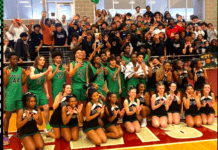Labor Day is annually held on the first Monday of September. It was originally organized to celebrate various labor associations’ strengths of and contributions to the United States economy. {{more}}
The first Labor Day was held in 1882. It became a federal holiday in 1894. All Government offices, schools and organizations and many businesses are closed.It was originally intended that the day would be filled with a street parade to allow the public to appreciate the work of the trade and labor organizations. After the parade, a festival was to be held to amuse local workers and their families. In later years, prominent men and women held speeches. This is less common now, but is sometimes seen in election years.Today, some public celebrations, such as fireworks displays, picnics and barbecues, are organized, but they are usually low key events. For many teams, it is the start of the football season.
One of the reasons for choosing to celebrate this on the first Monday in September was to add a holiday in the long gap between Independence Day and Thanksgiving. Source: TimeandDate.comThe following in the history of the Labor Day movement according to Wikipedia. (Click to see the foot notes in the below material).In 1882, Matthew Maguire, a machinist, first proposed the holiday while serving as secretary of the CLU (Central Labor Union) of New York.[2] Others argue that it was first proposed by Peter J. McGuire of the American Federation of Laborin May 1882,[3] after witnessing the annual labour festival held in Toronto, Canada.[4] Oregon was the first state to make it a holiday on February 21, 1887. By the time it became a federal holiday in 1894, thirty states officially celebrated Labor Day.[3]
Following the deaths of a number of workers at the hands of the U.S. military and U.S. Marshals during the Pullman Strike, the United States Congress unanimously voted to approve rush legislation that made Labor Day a national holiday; President Grover Cleveland signed it into law a mere six days after the end of the strike.[5]The September date originally chosen by the CLU of New York and observed by many of the nation’s trade unions for the past several years was selected rather than the more widespread International Workers’ Day because Cleveland was concerned that observance of the latter would be associated with the nascent Communist, Syndicalist and Anarchist movements that, though distinct from one another, had rallied to commemorate the Haymarket Affair in International Workers’ Day.[6]
Recent News Feed
SCHOOL NEWS
Local Weather
Kennedale
scattered clouds
72.8
°
F
74.6
°
70.4
°
71 %
1.4mph
44 %
Tue
99
°
Wed
101
°
Thu
97
°
Fri
98
°
Sat
91
°
Fellowhship Academy
Sports
2025 State 4A D2 Champions Kennedale Wildcats
State finals in pictures via University Interscholastic League
Kennedale Life
Columnist Corner
Deanna's Art
Why Community Matters
What is community? By definition, it is a group of people coming together over shared values and ideas. Lately, in our society that seems to be harder and harder to find. In an effort to be our true selves and explore our own beliefs,...
Counselor Susan's Couch
Suicide Prevention Week in the K.I.S.D. Intended to Raise Awareness, Spark Conversation
The week of September 6th through September 9th is being recognized and promoted as Suicide Prevention Week throughout the K.I.S.D. and students were encouraged to wear varying outfits and apparel items to align with themed days, all designed to raise awareness, prompt conversation, and...
COVID-19 vs. the Big 4 (what will actually kill you) Part 1
COVID-19 vs. the Big 4 (what will actually kill you) Part 1
By Guest Writer:
Jonathan Royston
We opened our gym, Dissent Athletics, on February 7th of 2020. About six weeks later, our gym, Kennedale, and the entire Nation shut down due to the COVID-19 virus. We...
The New Year and Resolutions
Welcome to the new year 2022!
I pray and hope this new year goes well for everyone. May the Lord crown this year with His goodness for us, and may our carts overflow with abundance of blessings (Psalm 65:11).
As another year begins , we have...
Five Ways to Cope with COVID Confinement
About 7 weeks ago our world changed. Life as we know it stopped. Schools closed. Restaurants closed. Bars closed. Gyms closed. The term “social distancing” became in vogue. Walking into a retail establishment with a mask on went from suspicious to requested. Diagnoses, prognoses,...
Movie Critic
The Best (in Film) for 2020… and the Worst
While I wish that I could say the past year will be best-remembered for all of the wonderful movies I had the pleasure of seeing, the truth is simply this: most were either average or barely above average, in my opinion, and one was...
Rhonda's Local Real Estate
Show Me the Real Estate Blog
So.....Real Estate.
Well. The new year has finally come upon us, and so far it doesn’t seem any less weird than 2020. So what does that mean for your most expensive investment? What does it mean if you're looking to buy your most expensive investment?...
Market priced senior housing designed around “pocket neighborhoods” coming to Kennedale
At the last Kennedale City Council held on September 17, the Council approved a new housing development for 439 Mansfield Cardinal between the Brookstone Estates and the Oakcrest Apartments and down from the Burger Box.
Full agenda available @ https://kennedaletx.civicclerk.com/Web/Player.aspx?id=2180&key=-1&mod=-1&mk=-1&nov=0
The "Cardinal Addition" will be designed...
Keeping Kennedale up to date in Real Estate
Real Estate is always such an interesting source of conversation, because it is of interest to just about everyone, whether you are buying, selling or investing. Our market here in Kennedale is a strong one, and as residents, you can be proud to call Kennedale home in a town that strives hard to make this a great place to live. In a new Gallup survey, only 21% of Americans think stocks or mutual funds are the best long-term investments; Real Estate came in as the most favored long-term investment, a position it has held since 2013.
LATEST NEWS
All
- All
- Archive
- Art
- Business
- City Government
- Councilman Chris Pugh's Corner
- Dating
- District Annoucements
- Event Calendar
- Fellowship Academy
- History
- Kenendale Jr High Student Publication
- kids
- KISD
- KISD School Board Annoucement
- KISD Sports
- Life
- Local
- Local Business
- Local Elections
- Local News
- Local Schools
- Mayor's Notes
- Medical
- Mental Health
- Movies & Books
- National
- Obituaries
- Opinion
- Pets
- Police Blotter
- Press Release
- Real Estate
- religious
- Revival Worship Center
- Sports
- Superintendent Corner
- Taylor's Corner
- Technology
- Theatre





































